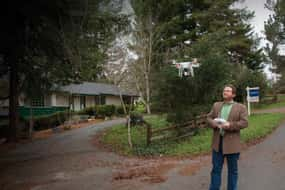NorthBay biz celebrates its 40th anniversary with a look at how the local real estate and construction industries have changed over the years.
Forty years ago, the population of Marin, Sonoma and Napa counties was 563,852. Today, that number has jumped more than 60 percent to almost 900,000 people. NorthBay biz spoke with real estate and construction professionals in all three counties about the major changes that shaped their industries and changed the way they did business. Most professionals agreed, whether they’d been in business for 20 years or 50, that the most dramatic changes have happened within the last two decades—proof of how quickly our world is changing.

Technology is king
Overwhelmingly, the change with the most impact in the last 40 years has been the use of technology expediting communication between businesses and clients. From the ease of quick sign-offs on documentation through online services like Docusign to consumers being better educated, informed and involved in the process of purchasing or building a house, technology has completely revolutionized the way we do business.
“The Internet and real estate applications such as Trulia and Zillow have made it possible for buyers and sellers to educate themselves prior to even contacting a realtor,” explains Fred Kusin, who’s been in the real estate business more than 20 years and currently works out of Petaluma and Santa Rosa for Bradley Real Estate, which boasts 13 offices in the North Bay and more than 400 agents. “When buying real estate 30 years ago, the drill was to have your agent pick you up and drive you to a handful of homes selected from the monthly Real Estate Listings Book. This book had only one picture of each home with a short description, and the agent only had one copy of the book. So being in the home was the first time a buyer could see the home.”
Today, the process of due-diligence, that used to take days, takes just minutes. The agent is armed with more information up front, which wastes less of the clients’ time, and the clients can review most of the listings on their own before even setting foot in a home.
“I believe the real estate industry has been one of the largest beneficiaries of the technology available today,” says Kusin. “Today, more than 95 percent of buyers find their home on the Internet first, due to the ease of use of websites like Trulia, Zillow and Realtor.com.
“I love integrating new technology ideas into my business. I create fly-over videos using drone technology for most of my listings; always use HDR Professional photography because today, the pictures mean everything; and I use social media to market homes. For example, I recently listed a high-end, modern home in Petaluma. The asking price was $1,495,000, and I wanted to market it to a specific demographic in San Francisco and Silicon Valley. Facebook let me target my campaign to the right audience, and it worked beautifully.”
With the amount of information available online today, real estate agents could conceivably sell and market their listings anywhere. This has sometimes produced challenges, in that competition among agents is more widespread.
 “You can compete with anybody in terms of getting information, usually,” says Marin-based Jerry Suyderhoud, who’s worked in real estate since 1978 and currently acts as senior vice president for Newmark, Cornish & Carey, which started in the South Bay in 1935 and today has 13 offices throughout the Bay Area. “You can have relationships with anyone, anywhere, based on the Internet, email and the like. Now, people outside your market can come into your market and compete with you.”
“You can compete with anybody in terms of getting information, usually,” says Marin-based Jerry Suyderhoud, who’s worked in real estate since 1978 and currently acts as senior vice president for Newmark, Cornish & Carey, which started in the South Bay in 1935 and today has 13 offices throughout the Bay Area. “You can have relationships with anyone, anywhere, based on the Internet, email and the like. Now, people outside your market can come into your market and compete with you.”Because of this, Suyderhoud says, personal relationships are more important than ever, as is knowledge of your marketplace and staying active within your community.
Technology has also changed the way construction businesses operate. Even if what is built, how it’s built, and the equipment and machinery used haven’t changed that drastically, the way a construction business is managed has. What used to be handled via pagers and radios is now managed via cell phones, the Internet and email—instantaneously.
 “The industry has completely changed because of cell phones and the Internet,” says Doug Hamilton, president and owner of Petaluma-based Oak Grove Construction, who’s been in the business since 1981. “Before, if you came up with a problem on the job, you’d have to call on the radio to reach someone in the office, and that person would call on the landline to the engineer, architect or inspector and try and describe what the problem was. The solution would be narrated to a receptionist, who’d type it up and fax it or put it in the mail. This whole process was inaccurate and could take as much as a week or two. Now, if you’re on the job and have a problem, you take a digital picture and send it with a text or call directly to get the answer. The speed and accuracy of information transfer has completely revolutionized estimating and project management.”
“The industry has completely changed because of cell phones and the Internet,” says Doug Hamilton, president and owner of Petaluma-based Oak Grove Construction, who’s been in the business since 1981. “Before, if you came up with a problem on the job, you’d have to call on the radio to reach someone in the office, and that person would call on the landline to the engineer, architect or inspector and try and describe what the problem was. The solution would be narrated to a receptionist, who’d type it up and fax it or put it in the mail. This whole process was inaccurate and could take as much as a week or two. Now, if you’re on the job and have a problem, you take a digital picture and send it with a text or call directly to get the answer. The speed and accuracy of information transfer has completely revolutionized estimating and project management.”It’s the law
Changing legal requirements is another major change that’s affected both the real estate and construction industries, especially within the last two decades. From exponentially more paperwork to more stringent laws and regulations to an overall greater amount of financial scrutiny (especially with the housing crisis within the last decade), firms have had to rapidly adapt, educate consumers and adjust to new requirements.
 “The financial scrutiny that’s occurred since 2007, the financial meltdown and the implementation of Dodd-Frank [aka Wall Street Reform and Consumer Protection Act] along with CFPB [Consumer Financial Protection Bureau] rules and expectations for lenders isn’t congruent with the public’s expectation of getting loans done,” says Scott Baer, executive vice president of California Mortgage Advisors, Inc., a full-service mortgage banker serving California since 1993 with five offices throughout the Bay Area, including two in Marin County.
“The financial scrutiny that’s occurred since 2007, the financial meltdown and the implementation of Dodd-Frank [aka Wall Street Reform and Consumer Protection Act] along with CFPB [Consumer Financial Protection Bureau] rules and expectations for lenders isn’t congruent with the public’s expectation of getting loans done,” says Scott Baer, executive vice president of California Mortgage Advisors, Inc., a full-service mortgage banker serving California since 1993 with five offices throughout the Bay Area, including two in Marin County.“I think that’s the biggest challenge—translating those changes to the consumer. The amount of paperwork, how complicated it is and the new provision of ‘ATR’ [the ability to repay], which was enacted in January, makes it a little more challenging to explain to the consumer what a standard loan is and what they’re calling a qualified mortgage and a nonqualified mortgage.”
For the construction industry, changing laws and regulations have occurred largely as a result of the environmental movement pushing to protect the environment, decrease pollution and save diminishing resources such as water. This has affected both the timing and cost of construction projects.
“Today, our industry is extremely conscientious about the environment. Projects of an acre or more require an erosion plan and permits,” says Hamilton. “There was a time when the industry didn’t have the scrutiny it does today. In years past, you moved dirt when you wanted and, if the dust blew, it was just part of the job. There’s a dramatic difference in what we’re required to do to protect the environment today. These regulations also affect the cost of the project—more time equates to additional cost.
 The time spent managing projects has increased dramatically with the additional paperwork that’s now required and the need to acquire permits that were unnecessary in the past.
The time spent managing projects has increased dramatically with the additional paperwork that’s now required and the need to acquire permits that were unnecessary in the past.“The lead time it takes before a job gets kicked off in the field has doubled or tripled in the last 10 years,” explains Mike Ghilotti, president and third-generation owner (with his brother, Dante) of San Rafael-based Ghilotti Bros., Inc., which started in 1914. “While most of the changes [over the last several decades] have had a positive influence in how we do business, the downside has been the increase in the number of people needed to run a project due to all the bureaucracy. It’s taken a lot of the fun out of construction, because nobody can get out in the field and actually build anything anymore. All our time is spent in the office!”
A change in quality and quantity
Conservation efforts have also changed the types of products being sold and used in construction. Overall, products today have a much higher level of sophistication in terms of performance. They have a longer life and are much more effective and efficient. Roofing lasted about 15 years in the 1970s; today, it lasts 50.
 “Product has improved dramatically over the years,” says Eric Ziedrich, president of the 139-year-old Healdsburg Lumber Company, who purchased the business in 1985 from his father (who acquired it in 1972). “Our company was definitely much more lumber-based in the ’70s and ’80s. For a lot of different reasons, including environmental and conservation measures, there’s less lumber being used today and more composition/engineered products. As an example, look at decking products: Years ago, redwood was the dominant deck material. Now, composite products like Trex, which is produced from sawdust and recycled plastic. For exterior siding, fiber cement board has replaced redwood or cedar.”
“Product has improved dramatically over the years,” says Eric Ziedrich, president of the 139-year-old Healdsburg Lumber Company, who purchased the business in 1985 from his father (who acquired it in 1972). “Our company was definitely much more lumber-based in the ’70s and ’80s. For a lot of different reasons, including environmental and conservation measures, there’s less lumber being used today and more composition/engineered products. As an example, look at decking products: Years ago, redwood was the dominant deck material. Now, composite products like Trex, which is produced from sawdust and recycled plastic. For exterior siding, fiber cement board has replaced redwood or cedar.”Environmental awareness is especially high in the North Bay, as reflected by the high rate of fines and sanctions from the California Department of Fish and Wildlife. And, while Ghilotti wishes the state and federal government had been more reasonable in setting deadlines for equipment upgrades and new purchases that were required for compliance, he agrees that focusing on impacts to our environment that stem from construction is the right thing to do.
Another significant change in the construction industry within the last 40 years has been the changing workforce. Many smaller, custom builders were pushed out of the marketplace through the downturn in the economy and subsequent decline in building projects. But the industry as a whole also has an aging workforce with fewer newcomers moving into the trades.
“The average age of a journeyman carpenter is probably in the fifties today, but it was a young man’s industry back in the 1970s and ’80s,” says Ziedrich. “One factor is vocational education in junior high and high schools. If you go back to the 1960s and ’70s, woodshop and metal shop were offered by most high schools. The kids were coming up through primary and secondary schools learning about construction and the trades. Both the interest and the commitment to vocational education and the trades have significantly diminished. There was no tech industry back then, so there weren’t as many career options as there are today.”
Businesses in the construction industry today are having an increasingly difficult time finding qualified employees to fill experienced trade positions. It’s a problem Ziedrich urges the industry to address.
What the future holds
With the world changing so rapidly, it’s difficult to envision what the next 40 years will look like. Most agree that technology will continue to revolutionize the economy in many ways by making business and communication simpler, faster and more effective. According to Terry Wunderlich, a realtor serving primarily Napa County since 1977 and associate partner for Terra Firma Global Partners, a boutique real estate company with eight offices in the North Bay (serving Napa, Sonoma and Marin counties), the pendulum may very well swing from doing business totally electronically back to more face-to-face.
“Technology is extremely important, and Terra Firma is on the cutting edge in that arena,” says Wunderlich. “We don’t have paper files—all our files are electronic. It’s easy to lose sight of the personal relationships that are the most important factor in a successful sale and purchase and get caught up in the ease of email, texting and electronic signatures. But while today’s world has allowed for ease of transmitting documents, building personal relationships makes it all worthwhile.
“You can’t lose sight of the personal touch that’s needed,” says Wunderlich. “You need to be able to have that face-to-face meeting with the client. The electronic stuff is great, but it doesn’t really complete the picture. We went from the totally personal, one-on-one, because that was the only way we could do business, to being able to complete it totally electronically. But you can’t lose sight of what it’s all about. You need that personal connection.”
Keeping this need for personal relationships in mind, Wunderlich believes the future may hold a shift from ever-expanding, large firms acquiring smaller companies to clients starting to prefer smaller, boutique firms that can differentiate themselves with a personal touch. Today, with so much work being done electronically, services that large and small real estate firms provide are increasingly similar. What distinguishes one firm from another will be the personal connection and rapport they can provide.
As the population in the North Bay continues to increase, the real estate and construction industries will surely continue to evolve.
“The amount of folks entering California and the United States continue to rise. It’s a supply and demand formula,” says Kusin. “California’s growth rate is holding steady at close to 1 percent per year and is now close to 40 million residents. We live in the richest and most beautiful state in the union, and I don’t believe that will change.”
Decades of Design
 Over the years, building booms and busts have dramatically affected the construction and real estate industries and how they do business. These same fluctuations have also affected the ancillary businesses that serve these industries. No exception is Napa-based Craiker Associates, Architects and Planners Inc., which has been responsible for more than 200,000 housing units across the United States and in Japan since 1972.
Over the years, building booms and busts have dramatically affected the construction and real estate industries and how they do business. These same fluctuations have also affected the ancillary businesses that serve these industries. No exception is Napa-based Craiker Associates, Architects and Planners Inc., which has been responsible for more than 200,000 housing units across the United States and in Japan since 1972.The firm specializes in designing, planning and renovating multi-family, high-density housing, historic buildings, custom homes and recreational facilities. In more than 30 years of work, architect and company President Chris d Craiker, AIA, NCARB, says the biggest changes in the architectural industry have come from the extensive use of electronic information technology, including the advent of the Internet as well as the now widespread use of computer technology for design and design documentation.
“The number one change is the Internet connecting everyone and everything for immediate responses and instant information,” says Craiker. “Number two is CADD, or ‘computer aided design and drafting.’ In reality, it’s computer drafting—there’s no ‘aided.’ However, the best designs almost always start with a pencil or pen.”
Another major change has been the astronomically long time it takes to get a project approved and built. Unfortunately, this has coincided with clients’ increasing demand for speed.
“Clients want an answer now, not next week,” explains Craiker. “And yet the necessary documentation for construction and municipal approvals has become enormous. At the beginning of the 20th century, building might only take three drawing sheets. Today, it’ll take 30 drawings and assorted documents to get a permit for a simple remodel.”
Because of the many hoops to jump through today, Craiker estimates he now spends approximately 20 percent of his time on actual design, 40 percent on administration and 40 percent seeking approvals. Sometimes, the process can take so long that market conditions change while the approval process is in progress.
“Documentation for approvals and construction becomes longer, while the market for the product may change,” says Craiker. “For example, a client sees the need for more retail space, starts the design process and, by the time it’s built—say, three to five years later—the retail market is saturated. Same with housing and apartments.”
As one to turn lemons into lemonade, Craiker has used the difficulty in getting approvals to differentiate his business and better serve his customers.
“We’ve built a business and reputation on getting things approved,” says Craiker. “This requires long-range forecasts, astute market perceptions and the return of the crystal ball.”
Craiker predicts holographic presentations are coming, plans will be in color and two-sided sheets, and 3D printing will be common not only for drawings but also for product samples and to build models and computerized construction. “The latter isn’t new,” says Craiker. “Manufactured homes and components have been around for more than a century, dating back to Sears Catalog homes. What’s on the horizon will be totally manufactured, plumbed, electrically circuited and finished structures.
“The home is an obvious candidate,” he continues, “but consider high rises and dense urban sites, where today’s archaic construction process won’t shelter the next billion people. That’s the real future of architecture and construction.”



